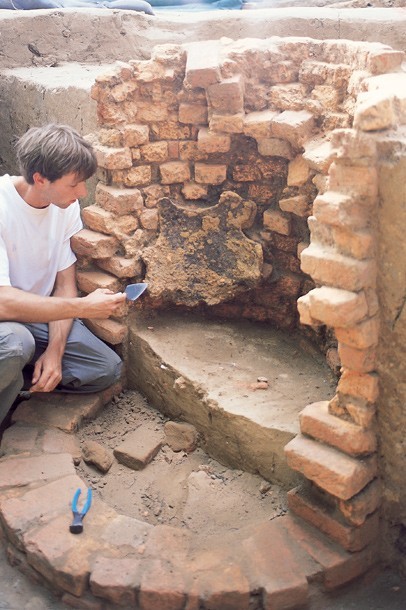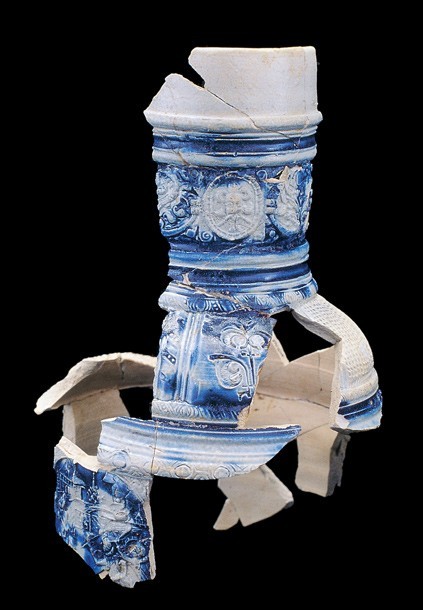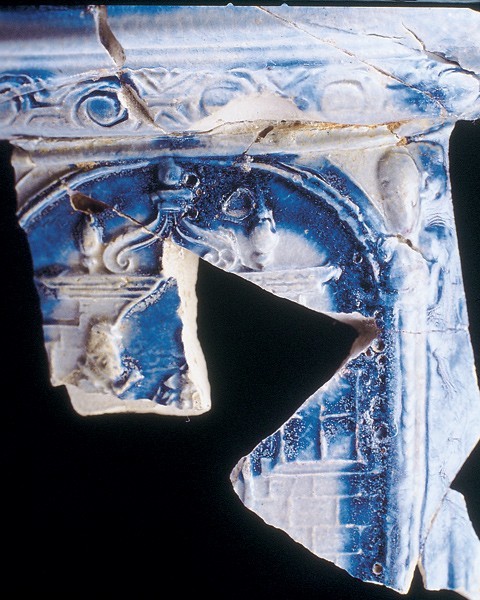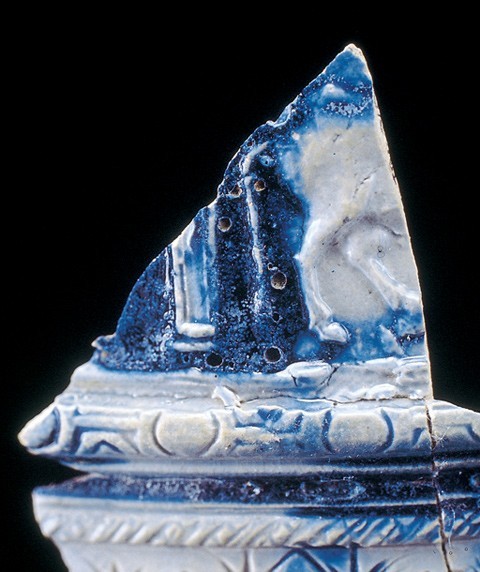
Association for the Preservation of Virginia Antiquities archaeologist Danny Schmidt excavating a breastplate from the top of an early seventeenth- century brick-lined well at Jamestown, Virginia. The well was full of military and domestic iron objects. Sherds of an early Westerwald stoneware jug depicting the biblical story of the Prodigal Son were found scattered throughout the well. (Courtesy, Association for the Preservation of Virginia Antiquities.)

Jug, Grenzau, Germany, 1618. Salt-glazed stoneware. This example parallels the archaeological Jamestown jug. The legend indicates that it was produced in 1618 in Grenzau.

Jug, probably Grenzau, ca. 1618. Salt-glazed stoneware. (Photo, Gavin Ashworth.) This archaeological jug is comprised of sherds recovered from the early seventeenth-century well at Jamestown.

Fragment of the jug illustrated in fig. 3. This is part of the first panel in the narrative showing the Prodigal Son departing on horseback with his inheritance. The German word Historia (history) appears in the arcade over the panel.

Fragment of the jug illustrated in fig. 3. The final panel on the jug, it depicts the Prodigal Son making amends with his brother.

Fragment of the jug illustrated in fig. 3. The first sherd of the jug found in the well, it shows the rear end of an animal, which later proved to be the fattened calf being led to slaughter for the Prodigal Son’s welcome-home feast.

Fragment of the jug illustrated in fig. 3. This panel displays the initials “Z L” on a plaque. Once thought to represent the initials of the jug’s maker, they are now recognized as being on a sign indicating the way to the brothel (Zur Lilie) in the Prodigal Son narrative.
Breathless from the 300-yard dash from the well he had been digging, the archaeologist appeared at the laboratory door. “Look what I found!” he exclaimed as he opened his muddy fingers and presented a sherd of blue and gray stoneware. The blue was so brilliant it appeared as if it had been made yesterday. “I think it’s a horse’s ass,” the archaeologist gasped. Sure enough, the sprig-molded design on the sherd showed the hindquarters of an animal with a long tail. This was just the first of seventy-one pieces of the same vessel—a stoneware jug manufactured in Germany—that was excavated from a well on Jamestown Island, Virginia, site of the English colony that was first established in 1607 (fig. 1).
Although located in the center of a Confederate earthwork erected during the Civil War, the well was built in the first quarter of the seventeenth century. This was determined by the dates of the artifacts unearthed in the trench surrounding the well that the colonists had dug as they constructed the brick-lined shaft. The objects found within the well itself suggest that it had ceased functioning as a source of water by the mid-1620s and was then quickly filled with debris.
The jug, which was discovered in pieces from top to bottom of the well, was produced in the Westerwald region of Germany near Cologne. Also known as the Kannenbackerland or “pot firing region” of Germany, the Westerwald “contains some of the richest sources of fine pottery making clays in north-west Europe.”[1] Its prominence in the production of stoneware blossomed at the end of the sixteenth century with the migration to the area of many potters escaping political unrest in Raeren (now Belgium) and Siegburg.
Westerwald products are common finds on American colonial sites through the seventeenth and eighteenth centuries. They were prized for their lightness, durability, and attractive decoration. After the Revolutionary War, however, American stoneware production in city centers such as Alexandria and Philadelphia and in the Valley of Virginia was able to compete with the Westerwald imports and eventually replaced them.
The Jamestown jug is a form known as a baluster jug. Sprig-molded friezes, derived from pattern books of designs used by the potters, decorate the neck and paneled body. The neck is ornamented in the Raeren style with grotesque masks in ovoid frames interspersed with relief floral strapwork. The midgirth reflects one of the biblical themes that became so popular in the Westerwald in the early seventeenth century. Seven panels, of which only fragments remain, depict the New Testament story of the Prodigal Son.
A complete “Prodigal Son” jug pictured in Otto von Falke’s Das Rheinische Stein zeug is a close parallel to the Jamestown jug (figs. 2, 3).[2] Besides the date of December 1618, a legend over the arcaded panels reads Historia von dem verloren Sohn wie Sant Lucas davon dut schriben (“History of the Prodigal Son according to Saint Luke”).
Parts of this legend can also be seen on the Jamestown fragments, such as the word Historia on the first panel in the narrative (fig. 4). It depicts the Prodigal Son on horseback, leaving home with his inheritance. Also recovered from the well was the final panel, which shows the Prodigal Son reconciling with his older brother who had been angered by all the fuss being made over the return of his errant sibling (fig. 5).
The “horse’s ass” that had excited the archaeologist is, in reality, the rear end of the fattened calf that is being slaughtered for the welcoming-home feast for the Prodigal Son. Parts of the legend as described above (. . . ie Sa. . .) are visible on this panel (fig. 6).
One of the recovered panel sherds raised much excitement, as it appeared to have the initials “Z L” and perhaps part of a date (fig. 7). Surely, it was thought, this must be the mark of the maker who could possibly be identified. Research soon proved that other scholars had been mislead by the same mark and that Otto von Falke had indicated in 1908 that the initials are part of the design.[3] “Z L” stands for Zur Lilie which means “to Lily’s house.” The initials are on a sign identifying the brothel from which the Prodigal Son had just been expelled.
The “Prodigal Son” jug has been retrieved from its watery grave and has returned to Jamestown. Just as the father in the Prodigal Son narrative states, “let us eat, and be merry . . . for he was lost, and is found.”[4]
ACKNOWLEDGMENTS
The author thanks Reinhard Straube for patiently translating and interpreting German texts.
Beverly A. Straube
Curator, Jamestown RediscoveryTM
Association for the Preservation of Virginia Antiquities (APVA)
Jamestown, Virginia
<bly@apva.org>
David Gaimster, German Stoneware 1200–1900 (London: British Museum Press, 1997), p. 251.
Otto von Falke, Das Rheinische Steinzeug (1908; reprint, Osnabrüch: Otto Zeller Verlag, 1977), pp. 90–92.
Ibid., p. 91.
Luke 15: 32.
